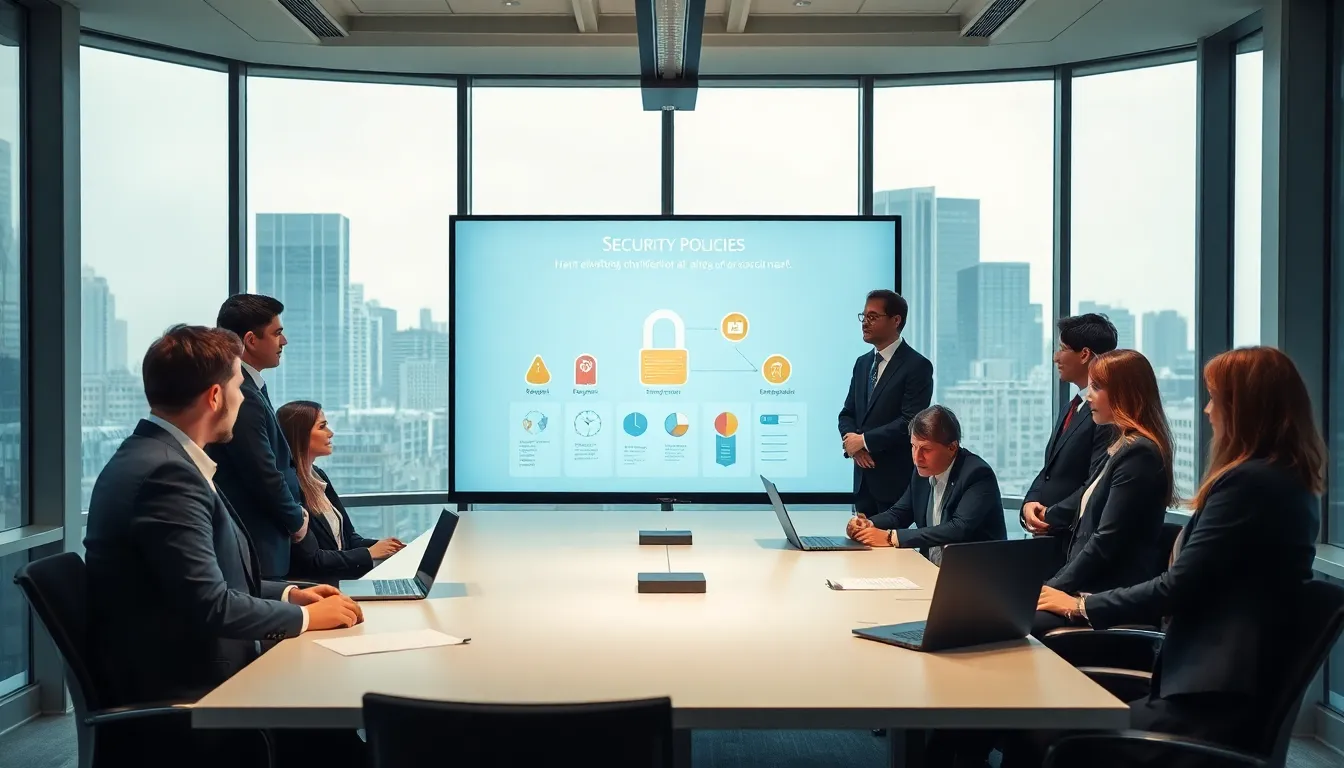In a world where cyber threats lurk around every digital corner, operational security controls are the unsung heroes of organizational safety. Imagine them as the security guards of your data, standing vigilant against intruders while you sip your coffee and pretend to work. They might not don capes, but these controls sure know how to save the day.
From safeguarding sensitive information to ensuring compliance with industry regulations, operational security controls are crucial for any business. They’re like the seatbelts of the cybersecurity world—often overlooked but absolutely essential. With the right measures in place, organizations can not only protect their assets but also enhance their reputation. So buckle up as we dive into the fascinating realm of operational security controls and discover how they can keep your business safe and sound.
Table of Contents
ToggleOverview of Operational Security Controls
Operational security controls consist of a set of processes designed to protect sensitive information. Their primary purpose involves identifying and mitigating risks associated with data handling and storage. Organizations implement these controls to ensure compliance with regulations and standards while strengthening their security posture.
Effective controls include personnel training and access management. Personnel training educates employees about potential threats and safe practices. Access management limits data access to authorized individuals only, reducing the likelihood of breaches. Procedures must be consistently reviewed and updated to address emerging threats.
Another vital aspect involves incident response plans. These plans outline steps for addressing security breaches quickly and efficiently. Timely responses minimize damage and ensure business continuity. Additionally, regular testing of these plans through simulations enhances readiness.
Regular audits and assessments form the backbone of operational security controls. Assessments identify weaknesses in existing measures and guide improvements. Audits provide visibility into compliance status and help organizations meet industry standards.
Advanced technologies like encryption and monitoring tools add layers of protection. Encryption secures data both at rest and in transit, making it unreadable to unauthorized users. Monitoring tools track access and usage patterns, flagging suspicious activity proactively.
Organizations benefit from building a culture of security awareness. Employees play a crucial role in maintaining operational security. By fostering an environment where security is prioritized, organizations enhance their overall resilience against cyber threats.
Types of Operational Security Controls

Operational security controls can be categorized into three main types: administrative controls, technical controls, and physical controls. Each type plays a crucial role in safeguarding sensitive information and enhancing an organization’s overall security posture.
Administrative Controls
Administrative controls involve policies and procedures designed to manage organizational security. Organizations implement these controls to define roles and responsibilities, enforce security protocols, and establish training programs. Training employees about security threats and safe data handling practices forms a key element of administrative controls. Additionally, background checks during hiring processes help ensure that personnel handling sensitive information are trustworthy. Regular reviews of policies maintain relevance and effectiveness in addressing evolving threats.
Technical Controls
Technical controls encompass software and hardware solutions aimed at protecting data. These controls include firewalls, intrusion detection systems, and encryption technologies that safeguard information from unauthorized access. Regular updates of software and systems are vital to close vulnerabilities that could be exploited by cybercriminals. Implementing multi-factor authentication (MFA) significantly enhances security, adding an additional verification layer for user access. Strong password policies also play a crucial role in ensuring that credentials remain secure and difficult to breach.
Physical Controls
Physical controls protect an organization’s assets and facilities against unauthorized access. These measures include secure entry points, surveillance cameras, and environmental controls to prevent physical damage. Security personnel can monitor access to sensitive areas, ensuring only authorized individuals enter critical locations. Implementing visitor logging systems allows organizations to track who accesses their facilities. Regular inspections of physical security measures help identify weaknesses that could expose the organization to risks.
Importance of Implementing Operational Security Controls
Implementing operational security controls plays a crucial role in safeguarding sensitive information from cyber threats. Protecting data involves identifying risks associated with its handling and storage. Organizations benefit from complying with regulations and enhancing their overall security posture by taking these measures.
Personnel training effectively educates employees about potential threats and safe practices related to data management. Access management limits data access to authorized individuals, significantly reducing the risk of breaches. Incident response plans outline steps for addressing security breaches swiftly, thus minimizing damage and ensuring business continuity.
Regular audits and assessments help organizations identify weaknesses in existing measures. They also guide improvements that strengthen defenses against evolving threats. Utilizing advanced technologies, such as encryption and monitoring tools, adds essential layers of protection to sensitive information.
Creating a culture of security awareness among employees is fundamental. A workforce that understands the importance of operational security strengthens the organization’s resilience against cyber threats. Without awareness, even the best technology can fall short in protecting vital data.
Three main types of operational security controls further underscore their importance: administrative, technical, and physical. Administrative controls establish policies which define roles and enforce security protocols. Technical controls include software and hardware solutions that guard data against unauthorized access. Physical controls ensure that organizational assets remain secure through secure entry points and surveillance.
By prioritizing these operational security controls, organizations can better protect their valuable information assets and maintain trust among clients and stakeholders.
Challenges in Maintaining Operational Security Controls
Maintaining operational security controls poses significant challenges for organizations. Skilled attackers constantly evolve, necessitating continuous updates to security measures. Personnel awareness also presents a hurdle; employees may underestimate the importance of security protocols, leading to potential breaches.
Furthermore, resource constraints often limit the ability to implement and maintain comprehensive security programs. Organizations may lack sufficient budgetary allocations for advanced technological solutions and ongoing training. As a result, outdated systems and policies can expose sensitive information to risks.
Conducting regular audits remains essential yet challenging. Identifying gaps in security controls requires dedicated time and resources that many organizations struggle to allocate. Consequently, without thorough assessments, vulnerabilities may remain undetected.
Effectively managing third-party vendors amplifies these challenges. Ensuring that partners adhere to the same security standards complicates relationships and can create vulnerabilities if not monitored closely. Compliance with industry regulations adds another layer of complexity. Organizations must navigate a maze of requirements, which can be overwhelming and divert attention from core business operations.
Building a culture of security awareness among employees also demands ongoing effort. Employees must remain engaged and informed about evolving threats and best practices. Implementing changes in personnel training schedules can help address this issue, but resistance to change can still diminish effectiveness.
Lastly, the rapid advancement of technology complicates the landscape. While innovations provide enhanced security options, they also require constant adaptation. Organizations must remain vigilant to avoid falling behind as new threats emerge.
Best Practices for Operational Security Controls
Organizations must implement comprehensive training programs for employees. Training reinforces awareness of potential threats and safe data-handling practices. Prioritizing access management also limits data access to authorized personnel only, significantly reducing breach risks. Regularly updating incident response plans is crucial, as these plans outline procedures for minimizing damage during security incidents.
Conducting periodic audits and assessments strengthens operational security measures. Audits identify vulnerabilities and help organizations adjust their security strategies effectively. Integrating advanced technologies like encryption and monitoring tools enhances data protection layers. These technologies offer real-time insights into security status, enabling quicker response times to threats.
Establishing clear administrative controls provides a framework for security. Policies defining roles, security protocols, and necessary training sessions ensure everyone understands their responsibilities. Incorporating technical controls, such as firewalls and strong password policies, further fortifies data security. Regular updates guarantee that these tools remain effective against emerging threats.
Promoting a culture of security awareness requires continuous effort. Engaging employees through regular discussions about cyber threats helps maintain vigilance. Addressing third-party vendor management enhances security posture as well. Organizations must ensure that their partners adhere to the same security standards to minimize vulnerabilities.
Navigating industry regulations can be challenging, yet focusing on compliance is essential. Incorporating compliance into daily operations ensures that security remains a top priority without overwhelming core business functions. Organizations that foster resilience against cyber threats through their security controls build trust with clients and stakeholders.
Operational security controls are essential for organizations aiming to protect sensitive information from evolving cyber threats. By implementing a layered approach that includes administrative, technical, and physical measures, businesses can significantly enhance their security posture.
Fostering a culture of security awareness among employees is crucial for minimizing risks and ensuring compliance with regulations. Regular audits and updates to security protocols help organizations adapt to new challenges while maintaining robust defenses.
Ultimately, prioritizing these controls not only safeguards valuable data but also builds trust with clients and stakeholders, reinforcing the organization’s commitment to security in an increasingly complex digital landscape.




